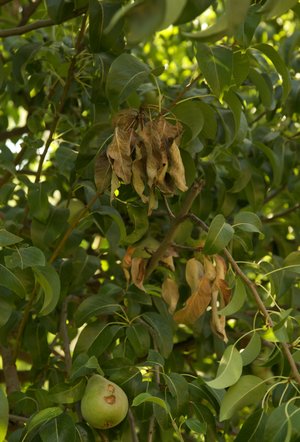
Later these tissues shrivel and turn brown to black. The floral receptacle, ovary, and peduncles become water soaked and dull, grayish green in appearance. Blossom clusters and young shootsīlossom symptoms are first observed 1-2 weeks after petal fall. Generally, symptoms of fire blight are easy to recognize and distinguishable from other diseases. Symptoms of fire blight can be observed on all above ground tissues including blossoms, fruits, shoots, branches and limbs, and in the rootstock near the graft union on the lower trunk. Today, fire blight is an important disease of apples and pears in many parts of the world. It was the first bacterium proven to be a pathogen of plants. HOSTS: Apple, pear, several rosaceous ornamentalsĮrwinia amylovora is a native pathogen of wild, rosaceous hosts in eastern North America. We comply with the Federal Trade Commission 1998 Children’s Online Privacy Protection Act (COPPA).Johnson, K.B.
Pear fire blight treatment code#
The 4-H Name and Emblem have special protections from Congress, protected by code 18 USC 707. Reference to commercial products or trade names does not imply endorsement by MSU Extension or bias against those not mentioned. This information is for educational purposes only. Quentin Tyler, Director, MSU Extension, East Lansing, MI 48824. Issued in furtherance of MSU Extension work, acts of May 8 and June 30, 1914, in cooperation with the U.S. Michigan State University Extension programs and materials are open to all without regard to race, color, national origin, gender, gender identity, religion, age, height, weight, disability, political beliefs, sexual orientation, marital status, family status or veteran status.
Pear fire blight treatment full#
MSU is an affirmative-action, equal-opportunity employer, committed to achieving excellence through a diverse workforce and inclusive culture that encourages all people to reach their full potential. Rootstock blight can be confused with Phytophthora crown rot, but rootstocks infected with Erwinia do not exhibit the reddening that is characteristic of Phytophthora-infected tissue, particularly below the soil line. Similar Speciesīlossom and shoot blight can be confused with Nectria twig blight, but can differentiated by noting that fire blight infections progress from infected blossom clusters or the tips of shoots downwards, where Nectria infections progress from the base of shoots upwards. Several of the newer dwarfing rootstocks have been selected for fire blight resistance. Rootstock blight is best managed through the use of fire blight-resistant rootstock. Pruning cuts should be made at least 30 cm below symptoms. It is important to prune out infected limbs as soon as symptoms are detected and before extensive necrosis develops. After bloom, management focuses on minimizing shoot blight and the development of cankers that overwinter and serve as next year's inoculum source. Managing blossom blight is achieved through well-timed bactericide sprays during bloom, usually streptomycin. Under favorable conditions, the bacteria may ooze from the rootstock, leaving streaks down the rootstock. Infected rootstocks are discolored and there is usually a sharp demarcation between infected rootstock tissue and scion tissue when the bark is peeled back (D). Rootstock blight is the result of infections that travel from infected blossoms or shoots into the rootstock, although direct infection of the rootstock through sucker growth is possible. The disease can progress to whole limbs and, when infection is severe, the whole tree appears to be scorched by fire, hence the name fire blight. Blighted shoots often form a characteristic "shepherd's crook" at their tip and the dead leaves remain clinging to the affected twigs (C).

On apple, the infected shoot becomes light to dark brown, in contrast to pear, in which the shoot becomes black. Infected shoots first have an oily appearance and turn a dark green.

Shoot blight develops in late spring or early summer on actively growing terminal shoots, including suckers and water sprouts. Infected fruit appear black and shriveled and usually remain attached to the tree. Flowers will cling to the infected stem and often remain attached throughout the season. Bacterial ooze may be observed under warm and humid conditions (B). In the shoot, the bacteria travel along the midvein of the leaves and they soon wilt, shrivel, and turn brownish black, killing the entire shoot. Typically, infected blossoms do not fall and bacteria progress into the tender shoot growth. Individual flowers or the entire cluster may be affected. Infected blossoms first exhibit a water soaking, followed by wilting and their eventually turning brown on apple and nearly black on pear (A). A sharp demarcation forms between the infected rootstock tissue and the scion tissue.īlossom blight occurs in the spring.


 0 kommentar(er)
0 kommentar(er)
